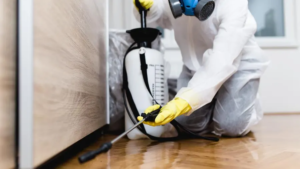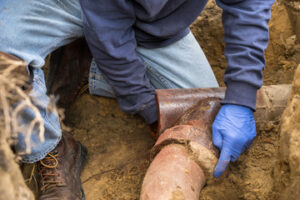Pests are organisms that damage plants or spoil human food, beverages, and other materials. Control is often accomplished through exclusion, repulsion, and/or chemical means.
Suppression is the usual goal in outdoor pest situations, although eradication is sometimes attempted. Eradication is more common in indoor environments. Biological control is generally included in integrated pest management programs. Contact Pest Control In Bakersfield now!

Biological control uses predators, parasites, and beneficial microorganisms to suppress pest populations. The goal is to minimize the impact on ecosystems and reduce reliance on chemical pesticides, which can have negative health and environmental impacts.
Unlike chemical insecticides, which kill pests instantaneously, biological controls take time to work. The success of biological control depends on the presence of suitable habitat, food sources and other factors that influence pest population growth. Biological controls are most often used in greenhouses and vegetable gardens, although they can also be found in open fields, wetlands (for purple loosestrife) and fruit crops.
The most common method of using biological controls is augmentation, which involves purchasing and releasing organisms to increase the number of natural enemies at or above the level required to suppress pest populations. This is most commonly done for insects but can include weeds, pathogens and other plant organisms.
These organisms are usually imported from other locations or cultures, but some can be “fortuitous” (adventurous) and arrive at the site of an exotic pest outbreak naturally without being intentionally introduced. These adventive species have been very effective in controlling pests such as the gypsy moth and cassava mealybug.
Most biological control agents are specific in the species of host they target. For example, the parasitoid wasp Trichogramma ostriniae only targets caterpillars, while nematodes can kill many different types of insects and are especially good at controlling thrips. This specialization in targeting helps reduce the risk of accidental exposure of unintended hosts and improves the ability of the organism to suppress the pest. Biological control organisms must also be protected from the effects of chemical pesticides, which can kill them. This can be done by limiting contact between the organism and the pest, reducing the need for spraying in areas of high population density or by using less persistent insecticides that have shorter periods of residue on leaves or fruits.
Pesticides
A pesticide is any substance used for the purpose of killing or controlling unwanted organisms such as insects, weeds or fungus. Common pesticides include herbicides to destroy weeds, insecticides to control a variety of insects, rodenticides to kill mice and rats that damage crops, and fungicides to prevent molds or mildews in plants and structures.
Ideally, a pesticide should be lethal to the target organism but not harmful to other organisms. However, the process of producing pesticides often results in impurities or contaminants that are toxic to living things. These substances are known as metabolites and may be more toxic than the parent compound.
Pesticides are primarily chemicals that are designed to kill organisms by disrupting their biochemical functions. They can be formulated into a variety of different products to accommodate the needs of specific applications. They can be systemic, meaning they move through a plant’s vascular system and are transported throughout the plant; or non-systemic, which means they stay on the surface of the leaves and stems where they can come into contact with an organism.
Most conventional pesticides are either systemic or non-systemic. Insecticides, for example, are usually systemic and work by inhibiting acetylcholinesterase, which causes the nerves to twitch and eventually cause paralysis.
Non-systemic pesticides remain on the surface of the leaves, stems and other parts of the plant where they can be contacted by an organism. They can also be absorbed through the roots, soil or water. When pesticides get into soil or water, they can travel to lakes, rivers and oceans where they can contaminate fish and other aquatic life. From there they can travel up the food chain, impacting humans and animals. Humans can be exposed to pesticides through ingestion, inhalation or direct skin contact. They can experience acute effects from exposure over a short period of time or chronic exposures from repeated low-level doses over a longer duration.
Resistant Plants
Using plants that are naturally resistant to disease is a key method of pest control. Plant breeders work to incorporate resistance traits into cultivars that are bred for crop production and home gardens. Resistant plants help reduce the need for pesticide use and conserve valuable agricultural land, water and fuel.
Some plants exhibit resistance to disease due to their structure and physical properties that interfere with the movement of insect pests. These include thick cell walls, surface wax and spines that can inhibit insect chewing mouthparts or the penetration of an insect stylet or ovipositor. Other plants display resistance through a natural defense mechanism called hypersensitive response, which causes the plant to quickly undergo programmed cell death to disrupt bacterial infections.
Most genetically modified (GM) plants with claimed resistance traits have what is referred to as race specific resistance. This means that the GM plant was bred for resistance to a particular biotype, pathotype, race or strain of disease-causing organism. If the same disease-causing organism develops a way to infect the GM plant and it can no longer be considered resistant, the disease resistance claim is deemed ‘broken down’.
For example, junipers are an excellent shrub for the landscape. They are drought tolerant, attractive in winter and summer and are highly resistant to deer. In addition, they produce fragrant foliage and flowers that attract pollinators and repel deer. Another excellent option is bee balm (Monarda spp.). This is an attractive perennial flower that attracts pollinators and deer are repelled by its pungent fragrance. Both juipers and bee balm are resistant to powdery mildew, a common disease of both annuals and perennials. To prevent disease, remove old flowers and debris and maintain good air circulation to limit fungal growth. Also, use a natural garden spray like Maggie’s Farm Simply Effective Garden Spray to keep your plants healthy and disease free.
Host Resistance
Host resistance is a form of biological control that relies on the natural defense mechanisms of a plant to combat disease. This type of host resistance works in conjunction with other control methods to provide the most effective pest management. In general, it works by preventing the pathogen from proliferating or gaining entrance to other tissues. This prevents the spread of the disease and gives the more potent immune responses time to develop.
Host plant resistance is a major component of IPM strategies and involves the use of crop varieties that are resistant to insect pests. These varieties are heritable and usually express one or more of three types of resistance: non-preference, antibiosis, and tolerance. Non-preference resistance involves a physical or chemical characteristic that makes the plant unattractive to insects, such as hairs, waxes, or a thick leaf cuticle. Alfalfa, for example, is bred with dense hairs to deter the spotted alfalfa aphid, while corn is genetically engineered with the Cry 1Ab protein from Bacillus thuringiensis to resist European corn borer.
Antibiosis is a result of chemicals in the resistant host plant that have an adverse effect on the biology of a pest, such as inhibiting their feeding or reproductive behavior. This type of resistance reduces the amount of damage done by the pest.
Tolerance is a result of the ability of a resistant variety to remain healthy and productive, even when the plant is damaged by an insect or disease. Insect-resistant crops are often used as an alternative to conventional spraying of broad-spectrum synthetic pesticides, which can harm beneficial insects and the environment, and contribute to resistance development by pests to these chemicals.
As with all control tactics, host resistance should be viewed as a tool in an integrated pest management strategy and should not be solely relied upon. As with other control methods, a farmer should always continue to scout and monitor for pests and diseases and use the appropriate cultural, physical or chemical controls as needed.
Natural Forces
Natural forces play a role in pest control by keeping populations of some insects, weeds and vertebrates under control. When these natural forces are disrupted, a pest population can grow out of control. Natural controls can include weather events, parasitoids, predators, nematodes, viruses and plant diseases.
A pest is an undesirable organism, such as an insect, weed, fungus, pathogen, or vertebrate animal that damages crops, food, feedstocks, human infrastructure, turfgrass, trees and landscape plants, ornamental gardens, lawns, or wildlands. Pests can also interfere with the use, health and function of soil, water and other natural resources, degrade habitat, and displace native species.
Some pests have no natural enemies and require the assistance of humans to keep their numbers under control. Such pests are called invasive or exotic pests. Examples include Japanese beetles and gypsy moths. Importation of natural enemies from their country of origin, often called classical biological control, can be used to manage invasive pests when other methods are not suitable or effective.
Natural enemies may be collected from their country of origin, or they can be produced in laboratories. They are then screened through a strict quarantine process to ensure they do not bring with them unwanted organisms such as hyperparasitoids or disease agents. They are then reared and released, typically in large numbers. Follow-up studies are conducted to evaluate their success and effectiveness.
Many factors can reduce the effectiveness of a natural enemy, including host plant resistance, physical characteristics of the pest, and chemical defenses that prevent natural enemies from attacking. Cultural practices such as tillage, which can kill or make unsuitable crop habitat for parasitoids and predators, can also lessen the effectiveness of biological control.








